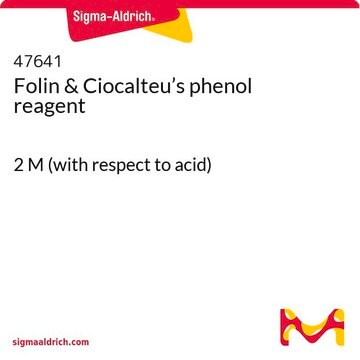G7384
Gallic acid
97.5-102.5% (titration)
Synonyme(s) :
3,4,5-Trihydroxybenzoic acid
About This Item
Produits recommandés
Source biologique
plant fruit
Pureté
97.5-102.5% (titration)
Forme
powder
Technique(s)
HPLC: suitable
Couleur
white to beige
Pf
251 °C (dec.) (lit.)
Solubilité
ethanol: 50 mg/mL, clear to slightly hazy, colorless to faintly yellow
Adéquation
suitable for UV spectrophotometry and general use
suitable for absorption spectrum analysis
Application(s)
agriculture
metabolomics
microbiology
vitamins, nutraceuticals, and natural products
vitamins, nutraceuticals, and natural products
Chaîne SMILES
OC(=O)c1cc(O)c(O)c(O)c1
InChI
1S/C7H6O5/c8-4-1-3(7(11)12)2-5(9)6(4)10/h1-2,8-10H,(H,11,12)
Clé InChI
LNTHITQWFMADLM-UHFFFAOYSA-N
Vous recherchez des produits similaires ? Visite Guide de comparaison des produits
Catégories apparentées
Description générale
Application
- as a standard for the quantification of extractable phenolics by external calibration
- as a standard to determine the total tannin content of oak root powder using the Folin-Ciocalteu method
- as a phenolic acid to study it′s in vitro antiviral, antibacterial, cytotoxicity and antifungal activities
Actions biochimiques/physiologiques
Caractéristiques et avantages
- High quality compound suitable for multiple research applications
- Compatible with HPLC and mass spectrometry techniques
Autres remarques
Mention d'avertissement
Warning
Mentions de danger
Conseils de prudence
Classification des risques
Eye Irrit. 2 - Skin Irrit. 2 - STOT SE 3
Organes cibles
Respiratory system
Code de la classe de stockage
11 - Combustible Solids
Classe de danger pour l'eau (WGK)
WGK 1
Point d'éclair (°F)
Not applicable
Point d'éclair (°C)
Not applicable
Équipement de protection individuelle
dust mask type N95 (US), Eyeshields, Gloves
Certificats d'analyse (COA)
Recherchez un Certificats d'analyse (COA) en saisissant le numéro de lot du produit. Les numéros de lot figurent sur l'étiquette du produit après les mots "Lot" ou "Batch".
Déjà en possession de ce produit ?
Retrouvez la documentation relative aux produits que vous avez récemment achetés dans la Bibliothèque de documents.
Les clients ont également consulté
Protocoles
HPLC Analysis of Polyphenols in Nero d'Avola Red Wine on Discovery® HS C18 (UV 280 nm)
Protocol for HPLC Analysis of Flavonoids on Ascentis® RP-Amide
Notre équipe de scientifiques dispose d'une expérience dans tous les secteurs de la recherche, notamment en sciences de la vie, science des matériaux, synthèse chimique, chromatographie, analyse et dans de nombreux autres domaines..
Contacter notre Service technique









